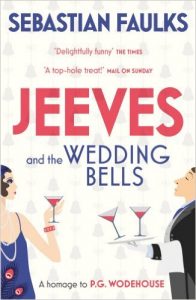I first read Jeeves and the Wedding Bells by Sebastian Faulks a couple of years ago, when it was published amid a slew of well-known authors venturing into fanfiction. There was this by the award-winning Faulks, but also Emma by Alexander McCall Smith, (not to mention the rest of Austen’s titles reimagined as part of a wider project) new Sherlock Holmes titles by Anthony Horwitz, Death Comes to Pemberley by PD James, and more – each of which involved not just creating a fresh story, but imitation of the original author’s style. I have already blogged here about Longbourn by Jo Baker, and using others’ work as a jumping off point for your own inspiration. In this case, Faulks set out to write a new story about Bertie Wooster and his valet Jeeves, the duo created in 1919 by PG Wodehouse. And I’m fascinated by Faulks’ skilled mimicry.
I am re-reading the book for pleasure, but also to examine again how Faulks achieves such closely-observed imitation of Wodehouse’s light touch and precision humour. It’s not absolutely perfect, but what could be? Wodehouse wrote almost 100 books, and a quick count suggests that I’ve read 38 of them, so I am rather familiar with his style. (Also, good news: 60-odd more books to read, if I can find them!)
Pinpointing what works in an impersonation, and what doesn’t, is great practice at close reading. It encourages you to examine not just the language used by the original author but also the rhythm, and the manner of sentence construction.
I find badly-chosen language is the first thing that jumps out. Elizabeth Bennet exclaiming, “Oh my God!” in casual conversation would leap from the page as something not found in the Austen originals. (Austen’s characters do say God at times – but the word is presented as “G-” when used as a curse, and only used otherwise in extreme circumstances.) Anachronistic language identifies a fake too – Dickensian characters ‘tuning out’ a boring conversation, or a Bronte heroine saying a carriage went ‘like the clappers’ – radio-related slang, and WW2 RAF slang respectively.
So how can we writers use imitation to improve our craft?
Imitation – references and resources:
Jeeves and the Wedding Bells – a brand new Bertie Wooster story by Sebastian Faulks.
PG Wodehouse official website
The Austen project – contemporary authors reimagine Jane Austen’s classics.
Sherlock Holmes – new stories in the original style, by Anthony Horwitz.
Death Comes to Pemberley by PD James – what happened after Elizabeth and Darcy were married.
How I write fanfiction – nine tips from me, for success in a very busy creative world.

Leave a Reply - let me know what you think!